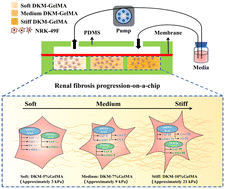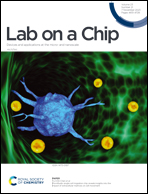A biomimetic renal fibrosis progression model on-chip evaluates anti-fibrotic effects longitudinally in a dynamic fibrogenic niche†
Abstract
Although renal fibrosis can advance chronic kidney disease and progressively lead to end-stage renal failure, no effective anti-fibrotic drugs have been clinically approved. To aid drug development, we developed a biomimetic renal fibrosis progression model on-chip to evaluate anti-fibrotic effects of natural killer cell-derived extracellular vesicles and pirfenidone (PFD) across different fibrotic stages. First, the dynamic interplay between fibroblasts and kidney-derived extracellular matrix (ECM) resembling the fibrogenic niche on-chip demonstrated that myofibroblasts induced by stiff ECM in 3 days were reversed to fibroblasts by switching to soft ECM, which was within 2, but not 7 days. Second, PFD significantly down-regulated the expression of α-SMA in NRK-49F in medium ECM, as opposed to stiff ECM. Third, a study in rats showed that early administration of PFD significantly inhibited renal fibrosis in terms of the expression levels of α-SMA and YAP. Taken together, both on-chip and animal models indicate the importance of early anti-fibrotic intervention for checking the progression of renal fibrosis. Therefore, this renal fibrosis progression on-chip with a feature of recapitulating dynamic biochemical and biophysical cues can be readily used to assess anti-fibrotic candidates and to explore the tipping point when the fibrotic fate can be rescued for better medical intervention.



 Please wait while we load your content...
Please wait while we load your content...